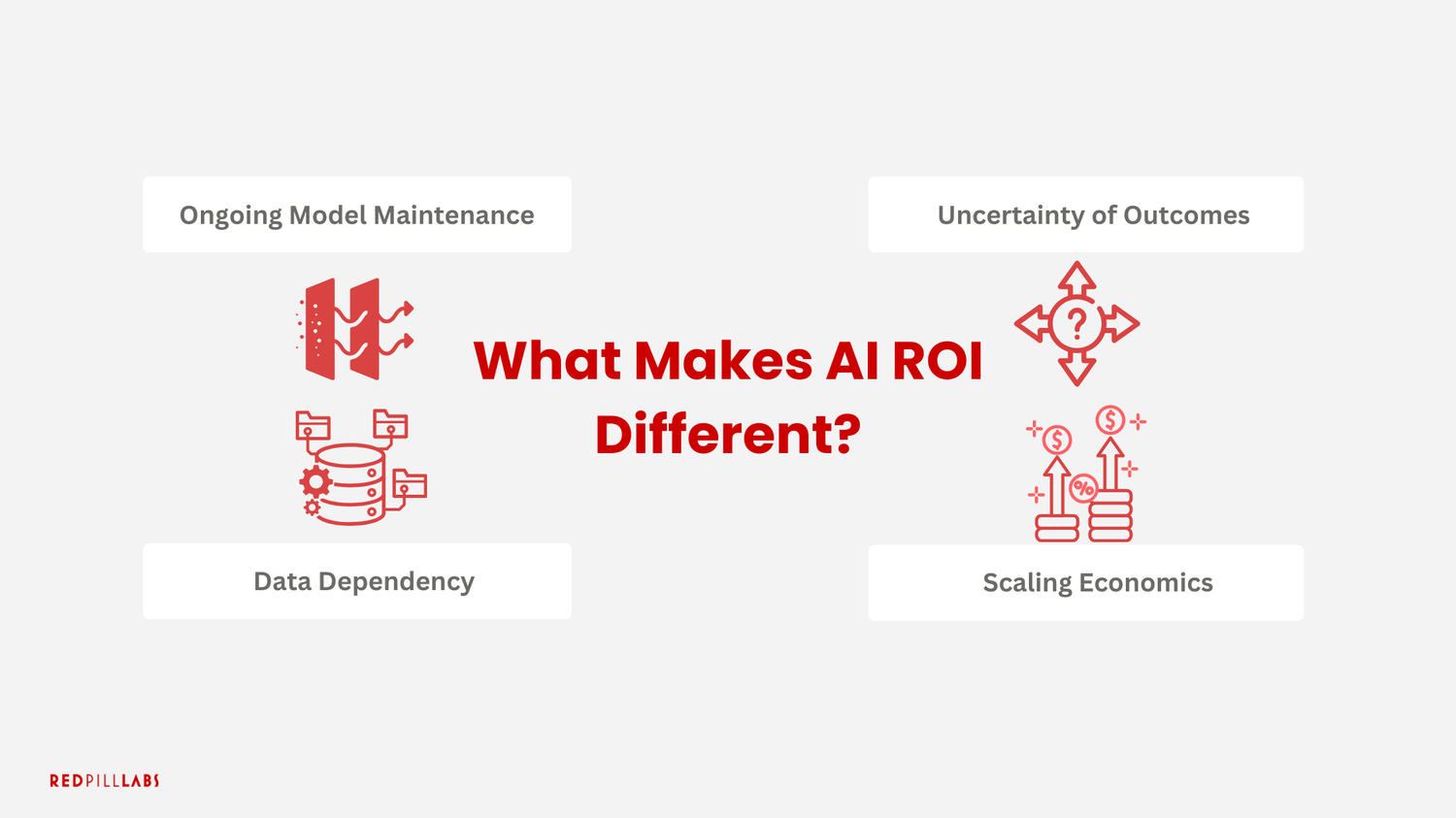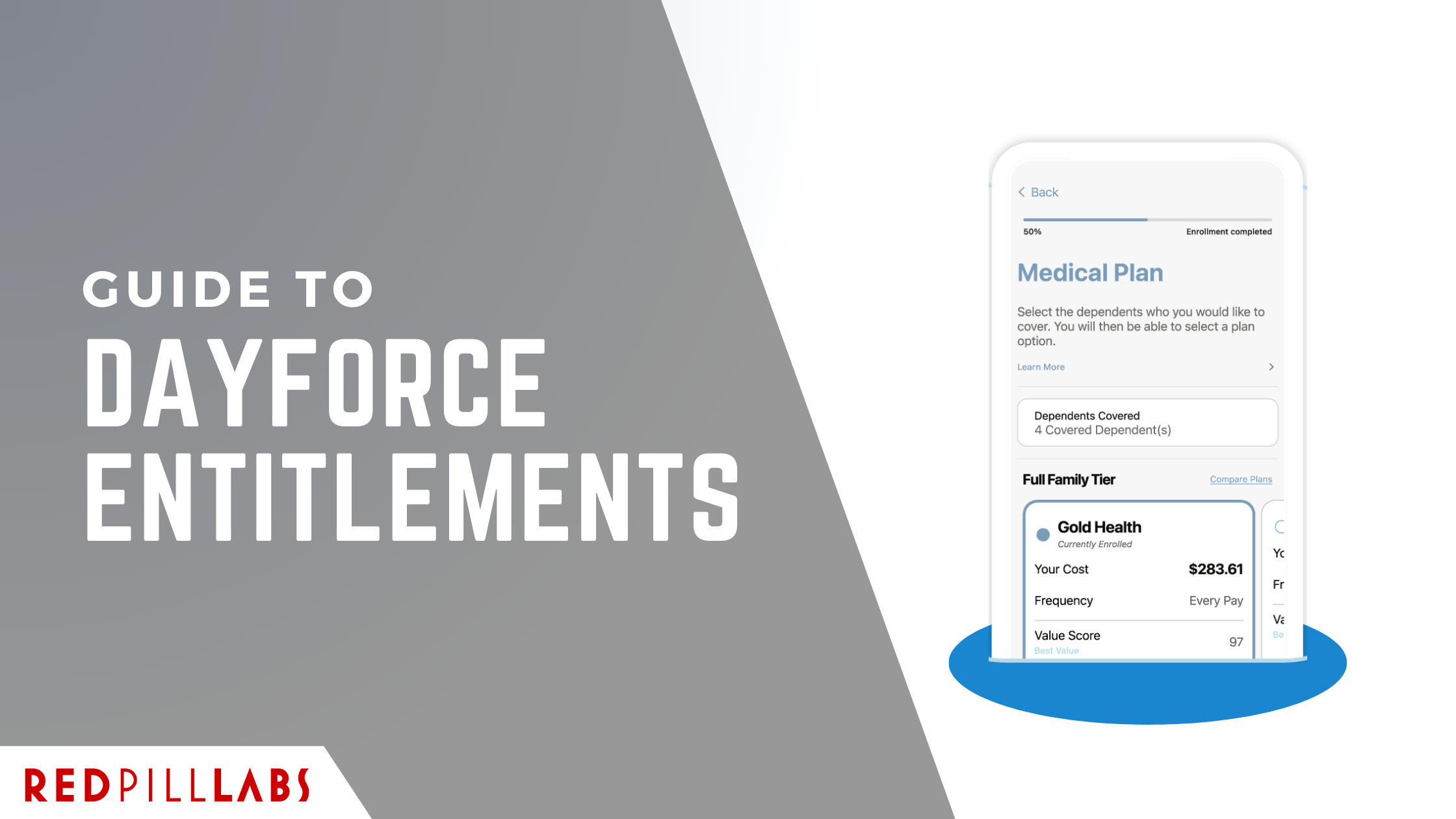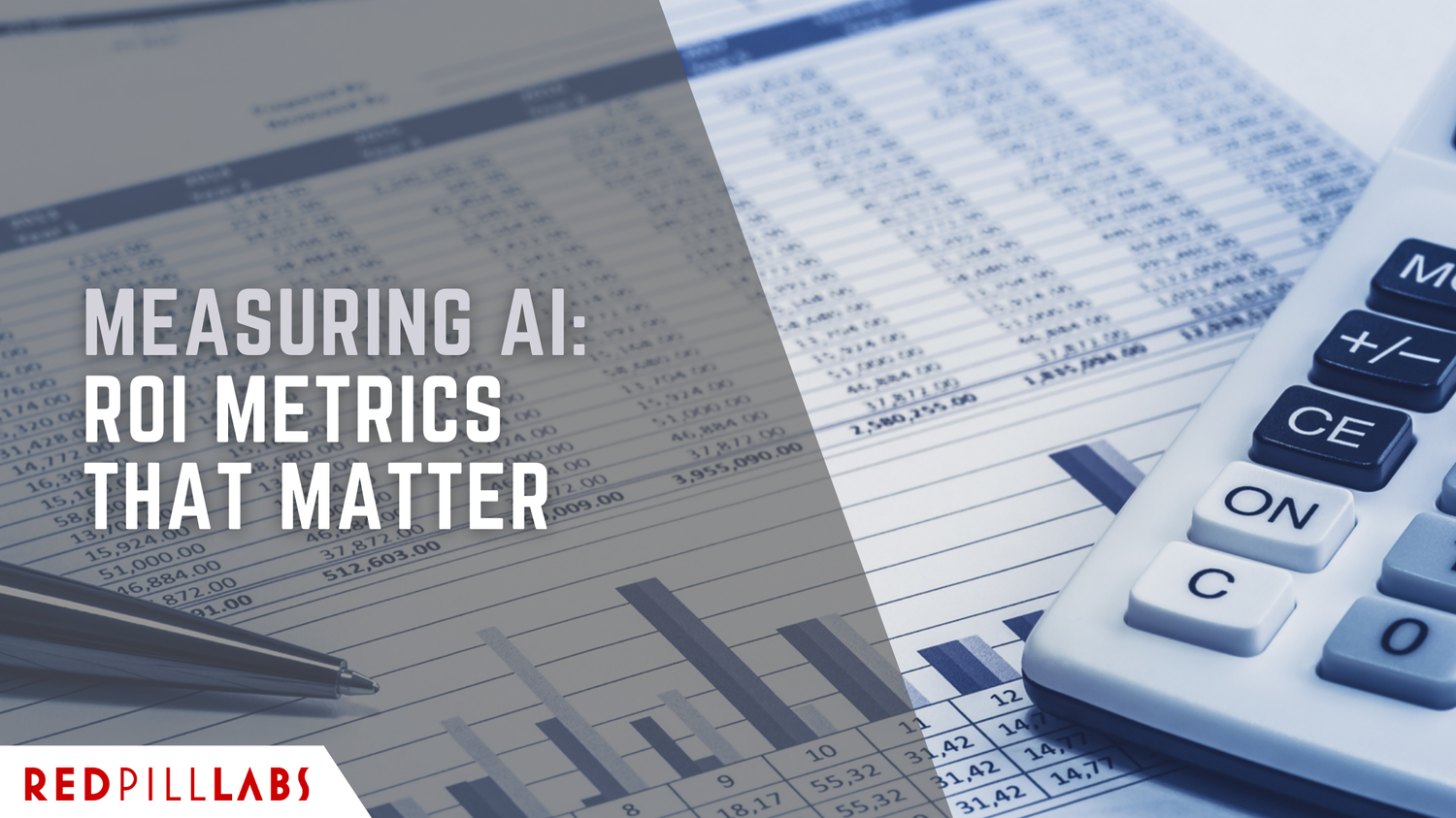Measuring AI: ROI Metrics That Matter
blog/measuring-ai-roi-metrics-that-matter
2025-08-18
For finance leaders, AI represents both promise and peril. The promise: automation, sharper forecasts, faster close cycles. The peril: expensive pilots that stall, data that doesn’t deliver, and vendors selling hype instead of outcomes. The differentiator between success and failure is often whether return on investment (ROI) is measured rigorously and meaningfully.
The challenge? Many ROI frameworks used in AI projects are either superficial ("we reduced manual hours") or misleading without added context ("our model’s accuracy is 98%!"). CFOs don’t have the patience for vanity metrics. They need ROI tied to outcomes that matter at the P&L, balance sheet, and enterprise strategy levels.
Below, we’ll break down the ROI metrics that actually matter — and why they stand up to scrutiny.
First, What Makes ROI for AI Different?
At first glance, ROI for AI could be measured the same way as any other technology: cost savings, efficiency, and revenue enablement. However, there are important differences leaders should recognize:
Ongoing Model Maintenance: Unlike traditional software, AI models can degrade or change over time (model drift). ROI must account for ongoing retraining, monitoring, and governance costs that are often overlooked in initial business cases. These recurring lifecycle costs should be forecasted over 3–5 years, and included in total cost of ownership, not buried as operating overhead.
Data Dependency: AI systems are only as good as the data feeding them. Cleaning, enriching, and securing data pipelines typically costs far more than the AI licenses themselves — and creates long ramp-up periods. Poor data quality is the number-one reason AI projects stall or fail. Visibility into these “hidden” data costs is necessary to understand their impact on implementation timelines and payback period.
Uncertainty of Outcomes: With ERP or workflow software, expected efficiency gains are relatively predictable. AI outcomes, by contrast, can vary based on business context and adoption. ROI forecasting for AI should therefore include ranges or scenarios rather than single-point estimates.
Emerging Technology: The wide frontier of emerging AI tools can make it difficult to determine when the right time to adopt, and invest is. Leaders should weigh the competitive risk of waiting too long: delaying adoption may protect cash in the short term, but it can also mean losing ground to competitors that are building capabilities now. Investments in early AI strategy, governance, and pilot projects often lay the groundwork for future implementation at scale, but have delayed benefits until those future projects are realized. Lengthened payback periods can significantly complicate ROI.
Scaling Economics: Traditional software scales linearly (more users = more licenses). AI scales differently: once trained, incremental use across processes can drive exponential ROI. But leaders must also factor in upfront infrastructure and data costs, which are no longer masked by cheap cloud compute alone.
In short, ROI measurement for AI shares the same financial anchors as standard technology but requires greater emphasis on lifecycle costs, data quality, adoption uncertainty, and governance.
To ensure accurate evaluation, establishing internal baselines for current performance before AI implementation is crucial. These baselines provide a benchmark for meaningful comparisons against post-implementation results.
Metrics That Matter
When evaluating AI initiatives, CFOs should demand metrics that translate directly into financial impact, not just technical success.
Quantifiable, dollar-denominated benefits — cost savings, revenue growth, risk reduction — that ultimately push AI projects forward.
Early wins create momentum, cultural gains sustain adoption, but CFOs and boards make decisions based on hard numbers. Four categories stand out:
Metric 1: Efficiency Gains
It’s tempting to declare victory when AI reduces manual hours. For example, if a reconciliation process that once took 40 hours a month now takes 10, that’s a clear win. But CFOs know efficiency metrics must go further:
Cost of redeployed labor: Freed-up hours only create ROI if they’re channeled into higher-value activities (analysis, forecasting, business partnering) rather than just “less busy work.”
Cycle-time acceleration: Shortening the month-end close or forecast cycle doesn’t just save time — it accelerates strategic decision-making, which compounds in financial value.
Workflow-level impact: Beyond tasks, AI optimizes end-to-end processes (production, logistics, inventory), unlocking scalability without proportional cost growth.
McKinsey estimates that automating financial planning tasks can reduce cycle times by up to 30%, which correlates with stronger responsiveness to market shifts. The key is not hours saved but strategic agility gained.
GenAI has shown to be able to provide a 30-50% increase in productivity in prototyping and deploying new code.
Metric 2: Accuracy Improvements
Forecasting accuracy and predictive capability is rated the number one most impactful AI feature by CFOs. AI can dramatically improve predictive accuracy, but ROI comes from risk avoidance:
Reduced forecast error: Even a 1–2% improvement in demand or cash flow forecasting can free up millions in working capital.
Fewer compliance errors: AI-driven anomaly detection reduces the risk of audit findings, regulatory penalties, or reputational damage.
Risk-adjusted planning: Tighter forecasts reduce volatility in cash flow and earnings guidance — highly visible at the board and investor level.
Example: If a $2B revenue company improves forecast accuracy by just 2%, it could free up $40M in working capital. Gartner finds finance functions using AI for anomaly detection cut compliance costs by up to 25%. Here, ROI isn’t just cost savings — it’s protection against downside risk. costs by up to 25%. Here, ROI isn’t just about cost savings — it’s about mitigating downside risk.
Metric 3: Cost Reduction
AI plays a pivotal role in cost reduction, with over 90% of C-suite executives recognizing its importance in reducing costs. Yes, AI can lower operating costs by automating repetitive tasks. But the real ROI emerges when those reductions flow through to measurable financial improvements:
Lower external spend: Reduced reliance on outsourced accounting or audit services.
Operational leverage: Scaling finance operations without scaling headcount.
Unit cost efficiency: Falling transaction costs per invoice, forecast, or report produced.
Companies leveraging generative AI for content development have reduced agency costs by 20-30%, with the cost of developing an unbranded website article dropping from over $20,000 to "nearly free".
Metric 4: Revenue Generation:
Most AI ROI conversations stop at cost savings. But the real value shows up when AI enables revenue growth. AI is a powerful catalyst for revenue growth and the creation of new business opportunities.
Dynamic pricing models: Optimizing price points with AI can drive top-line growth
AI-driven recommendations: Personalization has boosted average order value by 20% in e-commerce.
Faster time-to-insight: When finance delivers strategic insights sooner, organizations can capture opportunities competitors miss.
Retailers leveraging AI-powered predictive analytics can forecast customer purchasing habits with 90% accuracy, enabling them to predict demand and customize inventory to ensure the most sales are made and reduce stock wastage. These technologies also allow dynamic pricing, filtered product recommendations, accelerated order placements, easier shopping experiences, and increased customer satisfaction in stores.
These effects are harder to measure at the early stages of adoption but far more compelling. CFOs evaluating AI investments should push beyond savings into how AI accelerates or enables revenue growth.
AI ROI Lifecycle Framework
Beyond exclusively tangible, hard, cash value return, AI value emerges across a lifecycle: Trending ROI shows early proof points, Hard ROI delivers quantifiable financial gains, Soft ROI strengthens culture and agility, and Realized ROI captures enterprise-scale impact. Each stage represents a different kind of value — from confidence-building signals to transformational outcomes.
Traditional ROI calculations, focused solely on net profit, are often insufficient for AI investments, which deliver value through performance metrics, enhanced experience, and strategic capabilities.
Tracking the full ROI lifecycle is critical: it balances short-term signals with long-term financial impact, ensuring AI initiatives don’t stall in pilots but scale into enterprise-wide value.
1. Trending ROI (Early Signals – 0–12 months)
Progress-oriented indicators that show momentum before financial impact is fully realized.
Examples:
Data pipelines are unified, duplicated records reduced, and teams can find/use data faster.
Employee productivity improvements (e.g., 20% task time reduction, hours reclaimed)
Faster time-to-value (e.g., product launch cycle cut by 2 months)
Customer satisfaction signals
Business users adopt AI tools quickly and report higher trust in outputs.
Role in the Lifecycle: Trending ROI establishes confidence and provides proof points that justify scaling. Many of these benefits later mature into Hard or Realized ROI.
2. Hard ROI (Tangible Financial Benefits – 6–24 months)
Direct, quantifiable business outcomes that translate into financial impact.
Examples:
Cost savings (reduced labor, operational expenses, energy, compliance costs)
Increased revenue (higher sales, market expansion, improved conversion, larger average order value)
Productivity gains tied to measurable outputs (more transactions processed, throughput increases)
Error reduction leading to lower rework costs
Role in the Lifecycle: Trending productivity or CSAT improvements become Hard ROI when they can be tied directly to FTE capacity, revenue growth, or reduced costs.
3. Soft ROI (Strategic & Intangible Benefits – 12–36 months)
Difficult to quantify directly, but highly influential on long-term growth, retention, and culture.
Examples:
Improved employee engagement and morale → reduces turnover costs and preserves institutional knowledge
Enhanced customer experience → increases loyalty and lifetime value
Strengthened brand reputation → lowers cost of acquiring new customers
Greater organizational agility → faster adaptation to market/regulatory change
Accelerated innovation capacity → increased pipeline of new offerings
Link to Financials: Soft ROI indirectly drives measurable financial outcomes by lowering recruiting costs, sustaining revenue through loyalty, and reducing strategic risk.
4. Realized ROI (Enterprise-Scale Outcomes – 18–36+ months)
The full, quantifiable impact once AI is scaled and embedded into operations.
Examples:
Sustained revenue growth attributable to AI-driven features or markets
Predictive models hit higher accuracy → directly driving revenue (e.g., better demand forecasting reduces inventory costs by millions).
Large-scale cost reductions (automation replacing entire workflows, optimized supply chain)
Demonstrable risk mitigation (compliance adherence, reduced security incidents, reputational safeguards)
Consistent performance metrics (higher throughput, accuracy, cycle times)
Role in the Lifecycle: Realized ROI validates the strategic case for AI adoption and establishes it as a core business capability.
Best Practices: ROI Framework For AI
1. Translate Vendor Claims into Financial Terms
AI vendors often tout accuracy rates or processing speeds. CFOs should cut through the hype: How does this translate to reduced working capital, fewer write-offs, or faster revenue recognition? Only benefits tied directly to the P&L or balance sheet should count as ROI.
2. Account for Lifecycle Costs
Unlike ERP or workflow software, AI doesn’t stay “done.” Models degrade, data pipelines require upkeep, and compliance reviews are ongoing. CFOs should ask: What is the three-year cost of retraining, monitoring, and governance? Treat these as part of the investment, not hidden overhead.
3. Quantify the Data Burden
AI performance lives or dies on data quality. Many initiatives stall because of cleaning, enrichment, or security requirements. CFOs should demand a clear view of: What data preparation investments are needed, and how long until the system delivers results? Expect ramp-up periods that extend well beyond license activation.
4. Model Outcomes as Ranges, Not Absolutes
ERP efficiency gains are predictable; AI outcomes vary by context and adoption. That makes a single ROI figure misleading. Require scenario-based forecasts (best-, base-, and worst-case) to understand the true distribution of financial outcomes.
5. Evaluate Scaling Potential
Traditional software scales linearly with license counts. AI systems often scale non-linearly: once trained, extending them to new processes can be cheap and transformative. CFOs should ask: If the pilot succeeds, how quickly and cost-effectively can we expand into adjacent functions? Early ROI may understate long-term potential.
Next Steps for CFOs, CEOs, and Technology Leaders:
AI success doesn’t come from the algorithm alone — it comes from disciplined execution and measurement. To turn hype into enterprise value, leaders should treat ROI as a living framework, not a one-time calculation. That means auditing current initiatives, asking whether tracked metrics truly connect to financial outcomes, and defining ROI checkpoints at 3, 6, and 12 months to hold projects accountable.
Push vendors beyond surface-level claims like “model accuracy.” Demand proof of how AI impacts P&L levers such as cost savings, risk reduction, revenue growth, or strategic positioning. Equally important is leadership alignment: finance, technology, and executive teams must share a common view of what “AI ROI” looks like. Without that, projects risk stalling in the gap between technical success and business impact.
Before approving the next AI budget, pause on a few critical questions:
Which P&L levers will this initiative truly move?
How will success be measured — not just once, but quarter over quarter?
What are the hidden, ongoing costs of data, model retraining, and vendor reliance?
How will integration and risk be managed?
Does this strengthen our competitive position in the market?
When these considerations guide decision-making, AI shifts from an overhyped buzzword to a sustained driver of enterprise value.











